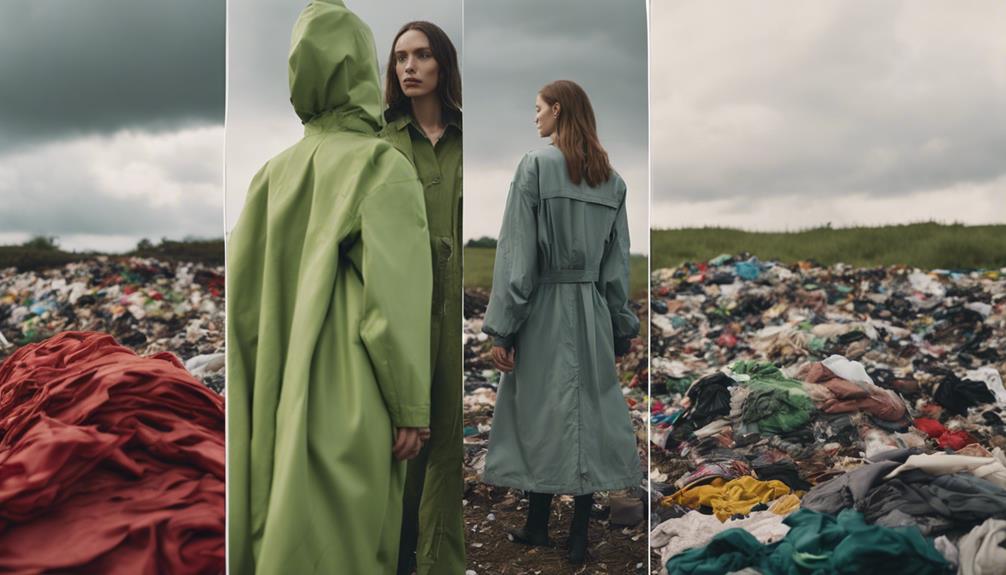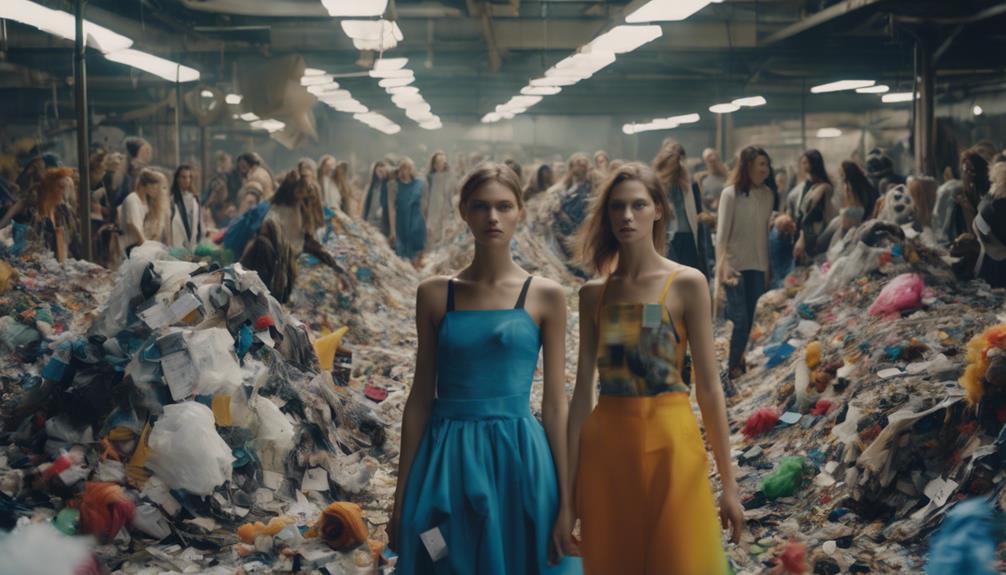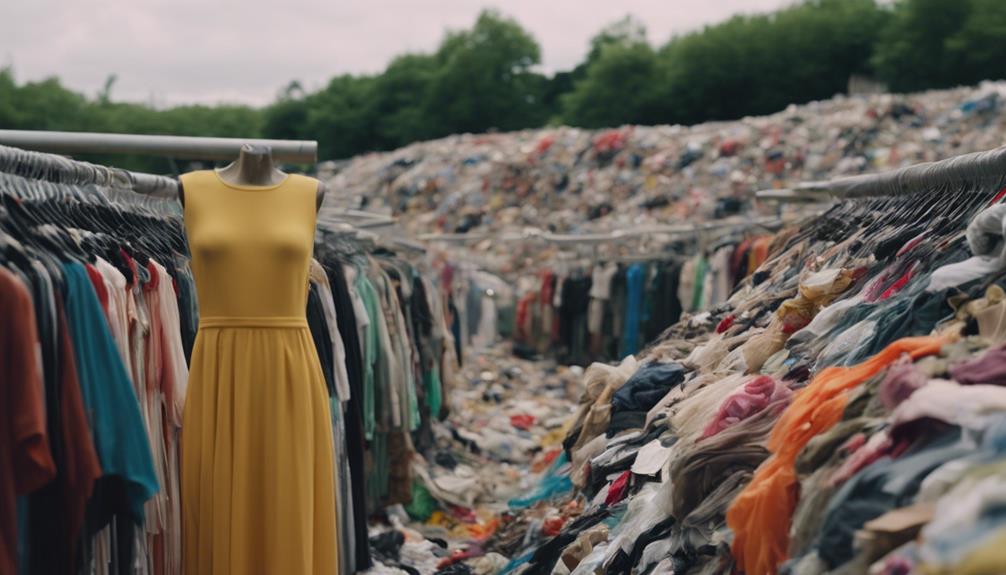Sustainable fashion is achievable, but it comes with obstacles that must be acknowledged. The fashion industry’s heavy reliance on fast fashion and the concerning levels of clothing waste are causing environmental damage. Many brands make ambiguous eco-friendly claims, making it difficult to discern what is truly sustainable. Exploitation of workers and low wages are still prevalent in this system. The pandemic has only added more challenges, emphasizing the need for a shift in practices and increased consumer awareness. Understanding the complexities of sustainable fashion is crucial in moving towards a more ethical future. Interested in learning more about how this transformation is progressing?
Key Takeaways
- Sustainable fashion is challenging due to the fast fashion model, which prioritizes rapid production and low costs over environmental and ethical considerations.
- Greenwashing complicates consumer choices, with many brands making misleading sustainability claims that lack clarity and accountability.
- Worker exploitation remains rampant, as many garment workers earn below living wages, leading to unsafe working conditions and ethical concerns.
- Post-pandemic challenges, such as resource depletion and production disruptions, hinder the growth of sustainable fashion initiatives and ethical brands.
The Reality of Sustainable Fashion
The reality of sustainable fashion reveals a troubling disconnect between marketing claims and actual environmental practices in the industry. While you might see brands touting their commitment to sustainability, the facts tell a different story. The fashion industry contributes 5-10% of global greenhouse gas emissions, with a staggering 85% of that coming from supply chains in the Global South. This significant environmental impact can't be ignored.
Despite the rise of sustainable fashion rhetoric, nearly 39% of sustainability claims made in textiles may be false or misleading. Major brands often capitalize on these claims to attract conscious consumers, yet the truth is that less than 1% of clothing is made from old textiles, and only 3% of garments utilize recycled materials. The fast fashion trend continues to worsen this issue, as clothing production doubled from 2000 to 2014, reaching around 100 billion garments annually.
You may believe that luxury brands are inherently more sustainable, but this myth overlooks the complex realities of production practices across all price points. Sustainable fashion isn't just a buzzword; it's a call for real change in an industry rife with contradictions.
Greenwashing in the Industry

Many consumers are caught off guard by greenwashing in the fashion industry, often believing brands' sustainability claims without realizing the misleading tactics at play. This deceptive marketing can create a false sense of security as you shop for ethical fashion.
Here are three common greenwashing tactics to watch out for:
- Vague Terminology: Brands frequently use terms like 'Ecodesign' or 'Conscious' without providing clear definitions or evidence. This can lead you to think their products are sustainable when they may not be.
- Recycling Claims: While many brands boast about using recycled materials, less than 1% of clothing is actually made from old textiles. This misrepresentation can mislead you into thinking you're making environmentally friendly choices.
- Misleading Labels: Labels that imply sustainability can confuse consumers, making it difficult to distinguish between genuinely ethical fashion and mere marketing ploys.
Understanding these tactics will help you navigate the fashion landscape more effectively. By being aware of greenwashing, you can make more informed choices and support brands that truly prioritize sustainability.
Misleading Claims by Brands

Consumers often encounter misleading claims from fashion brands that create confusion about the true sustainability of their products.
Approximately 39% of sustainability claims in the textile industry are potentially false or misleading, a clear indication of the widespread greenwashing prevalent among major brands. Companies like H&M and Decathlon have faced scrutiny for their eco-claims, leaving you wondering about the actual impact of your purchases.
Despite what brands may suggest, only 3% of clothing items in the market utilize recycled materials. This stark reality contradicts claims of widespread recycling practices, as less than 1% of clothing is made from old textiles. You might think you're making eco-friendly choices, but the truth is that most recycled materials aren't effectively reused.
Moreover, major brands often employ confusing labels and ambiguous certifications that lack clear verification of their environmental and social measures. This makes it challenging for you to discern which products are genuinely sustainable and which are simply part of the fast fashion cycle.
With misleading claims running rampant, it's essential to stay informed and critically evaluate the sustainability narratives presented by fashion brands.
Environmental Impact Overview

Fashion's environmental impact is staggering, contributing 5-10% of global greenhouse gas emissions, primarily from supply chains in the Global South. This pollution is compounded by wastefulness, as one truckload of clothing is incinerated or landfilled every second worldwide. Despite the fashion industry's increased production, the environmental impact hasn't appreciably improved over the past 25 years.
You might be surprised to learn that:
- Only 3% of clothing is made from recycled materials.
- Less than 1% of garments are produced from old textiles.
- Most products are crafted from non-biodegradable, petroleum-based materials.
The fashion industry's reliance on these materials, combined with ineffective recycling initiatives, creates a sustainability crisis.
Additionally, many brands engage in greenwashing, making misleading claims about their environmental impact without taking substantial action. This complicates your ability to make informed choices as a consumer.
Recognizing these facts can empower you to seek truly sustainable options while pushing for change in the industry. It's clear that addressing the environmental impact of fashion isn't just necessary—it's urgent. By supporting and promoting the sustainable fashion industry, we can contribute to the reduction of carbon emissions, water pollution, and waste. This can ultimately lead to a more equitable and environmentally-friendly industry that benefits both people and the planet. It’s crucial for consumers to demand transparency and accountability from fashion brands, and to actively seek out and support companies that prioritize ethical and sustainable practices. Only by collectively pushing for change and supporting sustainable options can we truly make a positive impact in the fashion industry.
Historical Context of Fast Fashion

Fast fashion started gaining traction after the 2008 recession, reshaping how you view clothing consumption.
As brands sought to cut costs, you might've noticed a rise in worker exploitation and economic shifts that affect wages.
Understanding these origins and their impact on people and the planet is essential for recognizing the need for sustainable alternatives.
Fast Fashion Origins
The late 20th century marked a pivotal shift in the clothing industry, as brands began to embrace a model that prioritized rapid production and low costs over quality and ethical labor practices. Fast fashion emerged as a response to consumer demand for trendy, inexpensive clothing, leading to an increase in global clothing production. This shift had a profound impact on the industry and its workers.
Major brands like Zara and H&M set the pace for fast fashion, producing new collections at lightning speed.
The 2008 recession fueled the desire for low-cost garments, further driving production pressures.
Outsourcing manufacturing to countries with cheap labor resulted in exploitative practices, jeopardizing workers' rights.
The Rana Plaza collapse in 2013, which claimed over 1,100 lives, highlighted the dangerous working conditions within the fast fashion industry.
As brands continued to churn out low-cost garments, the model's unsustainable nature became evident.
The relentless cycle of consumption leads to excessive waste and environmental degradation.
Understanding the origins of fast fashion is essential as we explore the possibility of sustainable alternatives in the fashion world.
Economic Impact Analysis
Economic pressures have driven the fast fashion industry to prioritize profit over ethical labor practices, greatly affecting workers and local economies worldwide. Since the 2008 recession, you've seen a surge in garment production, but this growth has come at a steep price. Wages have markedly declined since the 1970s, as fashion brands chase lower costs and higher profits.
The 2013 Rana Plaza collapse starkly illustrated these economic consequences, with over 1,100 fatalities prompting global scrutiny of the industry's practices. Furthermore, the rise of direct-to-consumer (D2C) models shifts financial risks onto manufacturers, allowing brands to monopolize the market while undermining local economies.
This concentration of power often leaves communities vulnerable, as the economic benefits of garment production rarely trickle down to the workers. Regulatory frameworks have struggled to keep pace with the industry's rapid growth, resulting in a lack of accountability for labor practices and environmental degradation.
The relentless cycle of fast fashion not only exploits workers but also contributes to a considerable negative impact on the planet, making it clear that the current model is unsustainable. It's time to reconsider what we value in fashion.
Worker Exploitation Trends
Garment production pressures have historically led to a cycle of worker exploitation, where low wages and poor conditions become the norm in the fast fashion industry. After the 2008 recession, many fashion companies ramped up production to keep up with consumer demand, often at the expense of workers. This trend has serious implications for labor rights worldwide.
Here are three key issues contributing to worker exploitation:
- Outsourcing Practices: Fashion companies frequently move production to countries with lower labor costs, maximizing their profits while compromising workers' rights.
- Inadequate Wages: Many garment workers earn less than $3 an hour, which is considerably below what's required for a living wage, leaving them trapped in poverty.
- Poor Working Conditions: The fast fashion model emphasizes rapid production, leading to unsafe and unhealthy work environments for factory workers.
As you can see, the fast fashion industry's prioritization of profit over people creates a troubling landscape. To make sustainable fashion possible, we must address these exploitative trends and advocate for fair labor practices.
Challenges Post-Pandemic

Steering through the challenges post-pandemic has become an intimidating task for many sustainable fashion brands, as they grapple with resource depletion and shifting consumer behaviors. Smaller ethical brands faced significant hurdles, like tonlè, which saw over $200,000 in order cancellations. This situation underlined the fragility of sustainable business models amid widespread retail closures and production disruptions.
Here's a snapshot of the challenges faced:
| Challenge | Impact on Brands | Effect on Garment Workers |
|---|---|---|
| Resource Depletion | Limited materials for production | Job insecurity and wage cuts |
| Order Cancellations | Loss of revenue | Reduced hours and layoffs |
| Retail Closures | Decreased visibility | Fewer job opportunities |
| Production Disruptions | Cash flow instability | Uncertain working conditions |
These challenges have not only strained brands but also affected garment workers who rely on stable employment. Despite the adversities, some retailers stepped up to support ethical initiatives, showcasing the importance of community during tough times. It's vital to recognize these ongoing struggles as the fashion industry seeks to rebuild sustainably.
Need for Systemic Change

The fashion industry urgently needs systemic change to address its significant environmental impacts and guarantee a more sustainable future. With 5-10% of global greenhouse gas emissions attributed to fashion, and 85% stemming from supply chains in the Global South, it's clear that current practices aren't cutting it. Incremental changes just won't suffice anymore.
Here are three key areas where systemic change is crucial:
- Regulatory Accountability: We need regulations to hold companies accountable for their environmental impacts. Market-based solutions have proven ineffective, leaving a gap that regulation can fill.
- Rethinking Business Models: Current models focused on recycling, rental, and resale don't adequately reduce the overall environmental impact. A fundamental rethink of the fashion system is essential.
- Collaborative Effort: Advocating for systemic change requires collaboration among investors, consumers, and brands. Together, we can push for a more equitable and environmentally responsible future.
Future of Ethical Fashion

To create a truly sustainable future in fashion, we must embrace ethical practices that prioritize both environmental integrity and worker equity. The future of ethical fashion relies on systemic change, where brands, consumers, and investors collaborate to minimize the carbon footprint of the industry.
Current models like recycling and resale aren't enough; they often fall short of considerably reducing the overall environmental impact. With 85% of the fashion industry's emissions stemming from supply chains in the Global South, demanding transparency in sourcing practices is essential.
As a consumer, you need to educate yourself about the industry's complexities, moving beyond superficial marketing claims about sustainability. Understanding the true cost of fast fashion will empower you to make informed choices that align with ethical principles.
Moreover, regulatory interventions are vital to hold companies accountable for their environmental practices. Market-based solutions haven't adequately addressed the challenges of sustainable fashion.
Only through collective action and a commitment to change can we foster a future where ethical fashion thrives, ensuring both the planet and its workers benefit. Together, we can redefine fashion for the better.
Frequently Asked Questions
What Is the Problem With Sustainable Fashion?
The problem with sustainable fashion lies in misleading claims, rampant greenwashing, and insufficient recycling efforts. You'll find that major brands often exaggerate their eco-friendliness, making it tough for you to make truly sustainable choices.
Do People Really Care About Sustainable Fashion?
You might care about sustainable fashion, but many don't actively seek it out. While most express interest, a significant gap exists between intention and action, often prioritizing low-cost options over ethical choices when shopping.
Can Fashion Really Be Sustainable?
You might wonder if fashion can truly be sustainable. While some brands claim to be eco-friendly, many fall short. Real change requires a shift in the entire industry, not just superficial efforts.
What Is the Paradox of Sustainable Fashion?
The paradox of sustainable fashion lies in its claims versus reality. While brands tout eco-friendly practices, production increases, greenwashing prevails, and systemic issues persist, making it hard for you to trust their sustainability efforts.
Conclusion
You might think sustainable fashion is just a pipe dream, but it's more possible than you realize.
By demanding transparency and holding brands accountable, you can drive real change in the industry.
Sure, it's challenging, especially with the allure of fast fashion, but every small step counts.
Embrace thrifting, support local designers, and educate yourself on ethical options.
Together, we can reshape the future of fashion into something that's not only stylish but also sustainable.









